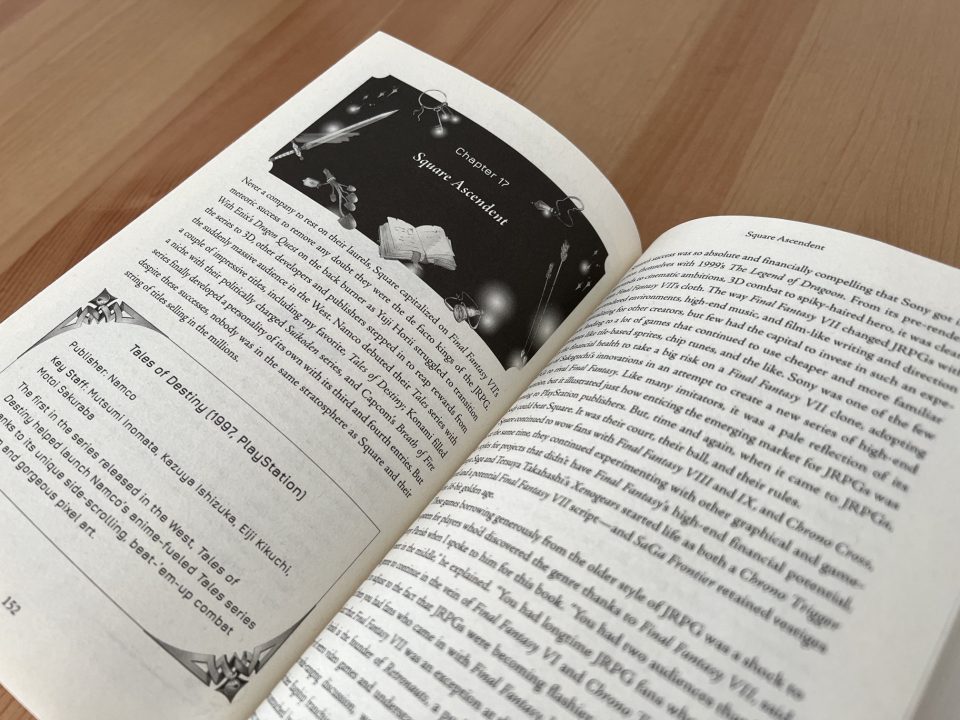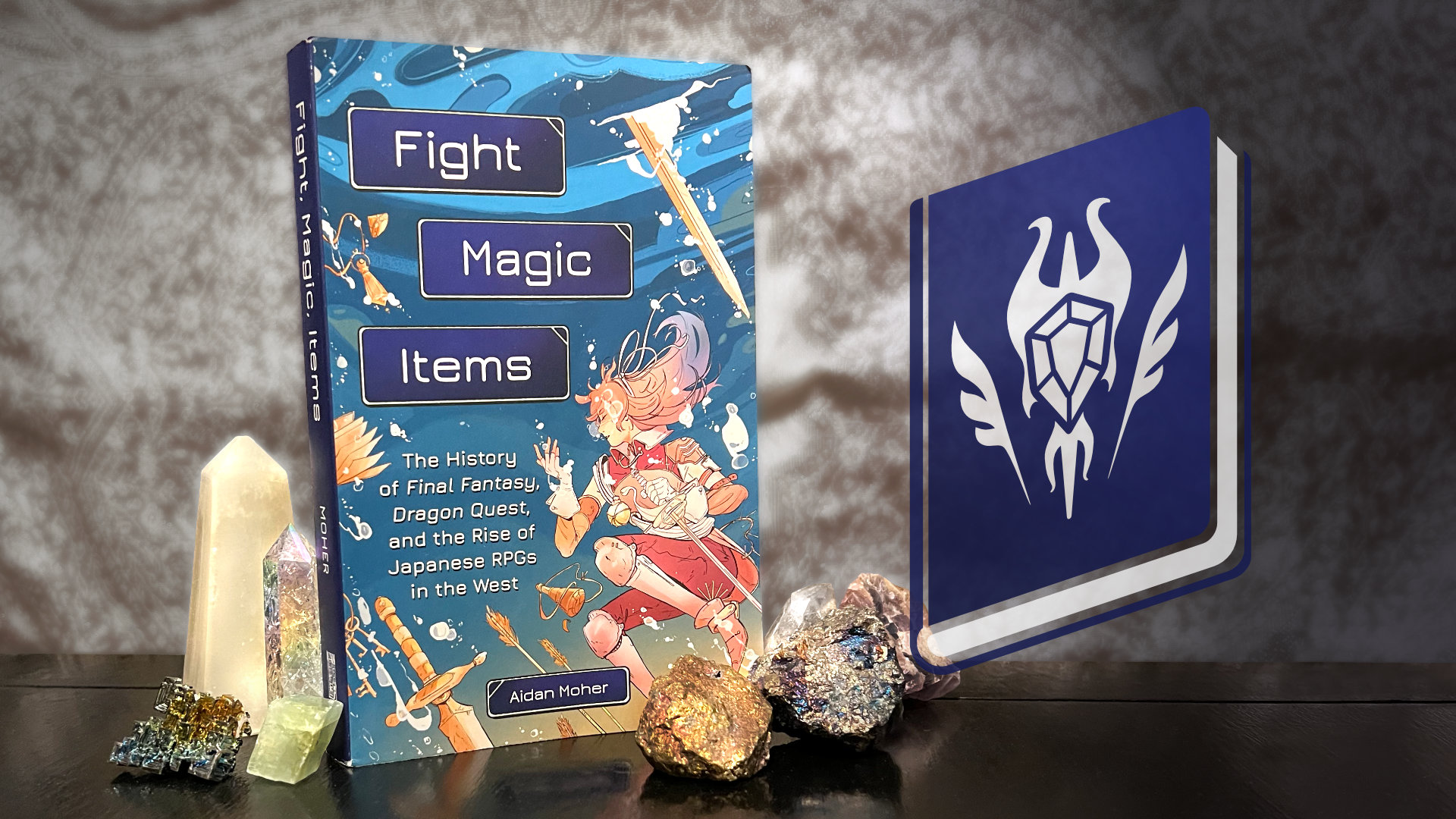The full subtitle for this book is “The History of Final Fantasy, Dragon Quest, and the Rise of Japanese RPGs in the West.” It chronicles a personal journey through years of classic (and rare) RPGs. Author Aidan Moher himself prefaces the book by saying that it reflects his personal experience with the genre and that he’s an “unreliable narrator.” I find that slightly misleading because—as he also points out—RPGs encourage us to bring our own reflections and experience into the game and narrative. By relaying his expertise, he’s created a work that will resonate with many of us who grew up with the genre and watched its rise as we ourselves grew into adulthood.
I became hooked on RPGs after watching a friend’s older brother play Final Fantasy IV and seeing women in a fantasy setting squaring up against impossible odds and summoning mysterious and powerful mythological beings. For the author, it was a babysitter bringing Final Fantasy VI for him and his brother to try. The larger point that Moher illustrates throughout Fight, Magic, Items is that these moments are a shared experience among JRPG fans and that it’s connected to a much larger narrative about some incredibly visionary creators, technological advances, and how fans have shaped the trajectory of our favorite genre just as it was shaping us. How fitting this is in a climate where Portopia Serial Murder Case has a remake currently in process, and the genre has matured enough that publishers like Boss Fight and Bitmap Books are turning the critical lens back on these RPG experiences.
Of course this type of tale needs a clear throughline, and that’s where Final Fantasy and Dragon Quest come in. Fight, Magic, Items is divided into chapters roughly chronologically and based on what was going on with both of those series at the time. This is not limited to beloved creators Hironobu Sakaguchi and Yuji Horii, though it starts by discussing the Western PC RPGs such as Wizardry and Ultima that inspired both of them. Instead, the book’s scope increases greatly as it progresses, growing to encompass larger companies like Square Enix and tracking Western reception to each release in these franchises, as well as how they inspired OTHER creators and how those titles were, in turn, received.
As a result, Fight, Magic, Items really becomes a history of RPG reception, and I truly appreciate how it maintains a positive, even-handed tone even when detailing upheavals like Square’s decision to release Final Fantasy VII on the PlayStation and, well, the lack of RPGs on the Nintendo 64 in general. Even when both major series were struggling to transition to more technologically advanced consoles or there were years between mainline releases, the focus was on why that is and the consequences it had for the players. In a few cases, this leads to some of my favorite chapters: the ones that discuss what happened in the wake of these behemoth titles, like the West’s introduction to the “weird and wild” world of Yoko Taro, how Pokémon helped popularize the turn-based battle for an entire generation of kids, and Itoi’s desire to use videogames’ relatively new narrative format to tell strange and poignant stories with the Mother series back in the ’80s and ’90s.
Charting major RPGs’ monetary and business fate is one facet of their success and reception. It provides some much-needed context for the cascade of decisions, game development, and company decisions that led to where we are now, on the eve of a mainline Final Fantasy spearheaded by a wildly successful MMO team and a darker-looking Dragon Quest potentially with new music (!!). However, that doesn’t touch on the deeply personal, emotional effects these games have had on many of us. That is arguably the more important, lasting impact (hence, my favorite chapter selections). That feeling of meaning and connection is primarily why we play, what has inspired us as we go through our lives as fans, and what has led to the genre’s staying power. For this reason, Fight, Magic, Items is arguably at its best when it tells stories on that level and is not bogged down by an expansive scope. I gained some insight from the little information boxes on some of Moher’s favorite games, explaining their experience and how the game fits into the context of the chapter and general RPG history, though I must concede that you do need both types of information.

There is a trove of extensive information in this volume. It’s been thoroughly researched, with interviews, facts, figures, and evidence to support conclusions on how events shaped the trajectory of RPGs. Many of these are quotes from the creators themselves, which lends an air of credibility. The time and attention Moher pays to the contributions of entire development teams, especially writers, artists, and composers, also makes the story feel complete. But again, because of the personal touches, it reads like a very well-informed and well-spoken friend discussing the evolution and future directions of a shared hobby. Even if you are knowledgeable about the history of RPGs or at an age where you lived through many of the cataloged events happening, this book will likely provide you with further detail or a new perspective on a specific time period. My favorite example of this is the idea that when RPGs were struggling to catch up with technological advances on consoles, there was often a robust market of memorable games on handhelds.
At this point, I would be remiss not to mention that this book will hit differently depending on your age or when you first started playing RPGs. Moher playfully hints at this when he discusses Final Fantasy entries, hinting that his favorite (VI) and other contenders, including Sakaguchi’s favorite (IX), correlate with age. No matter what your entry point into the genre, you’ll still enjoy reading the book, but the personal connection may be lacking in the earlier chapters if you are younger or have not played many games from the Nintendo and Super Nintendo eras. Selfishly, I was pleased to see all my favorites, from the old Quintet Heaven and Earth trilogy to Shadow Hearts, represented.
The book closes with an optimistic take on the future: RPGs have a long history of adapting and changing, clearly visible as the preceding chapters unfold. One thing we can do to ensure its success is to reflect and carry lessons from RPG experiences past into the future, and that is exactly what reading a book like this will help accomplish. As Moher says, “Nostalgia is hot, but it’s not opposite to change. Instead, they travel together. And, for the first time in the genre’s lifespan, it’s no longer Hironobu Sakaguchi and Yuji Horii who I have my eyes on, but the kids who grew up playing their classic games…”
Fight, Magic, Items is available digitally or as a trade paperback. It even has its own website where you can learn more and buy, or you can access it through the publisher’s site.
Disclaimer: This review is based on a copy of the publication provided by the publisher. This relationship in no way influenced the author’s opinions.



